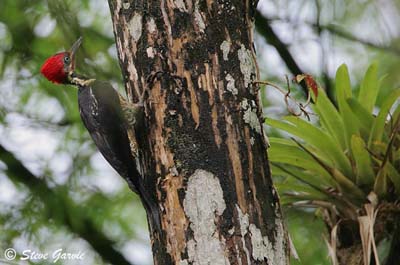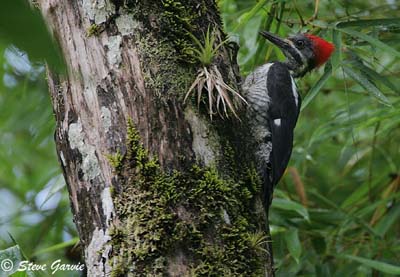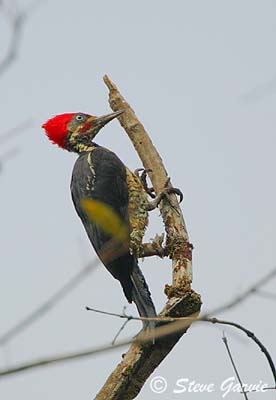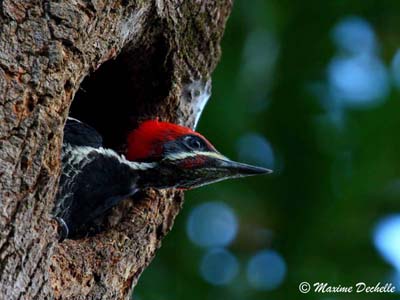
Lineated Woodpecker
Dryocopus lineatus
Piciforme Order – Picidae Family
BIOMETRICS:
Length: 34-36 cm; Weight: 200 g
DESCRIPTION:
Lineated Woodpecker is a large woodpecker.
Adult male has black upperparts, with two white stripes on back sides which form broken V. Rounded wings and tail are black. Tail is strong with stiff feathers.
On the underparts, throat is black, finely streaked with white. Breast is black. Belly, flanks and vent are buffy-white barred with black.
We can see white stripe from base of the bill, running below the eye and downing to the neck sides.
On the head, crown shows conspicuous red crest. It has red moustachial stripe. Head sides are black.
Large, straight, pointed bill is horn-coloured with darker tip. Eyes are pale yellow to bluish-white. Legs and feet are grey. It is zygodactyl, with two toes forwards and two toes behind.

Female resembles male, but she has black forehead and moustachial area.
Juvenile has dusky eyes, dark brown, and young male has blackish moustachial stripe, and indistinct black barring on underparts.

VOICE: SOUNDS BY XENO-CANTO
Lineated Woodpecker gives rapid, loud, laughing series of “yih-yih” or “nyeh-nyeh”, usually rising and falling. It also utters a ringing “wic-wic-wic” or “chik” or choik”, followed by a kind of growling “ahrrrr” or “urrrr”, giving “chik-chik-chik, chik-urrrr”.
Both sexes perform hard and rapid drumming, and rolls of 5 to 8 taps slowing slightly towards the end.
HABITAT:
Lineated Woodpecker is found in large trees in mangroves along coasts and inland forests, in forest edges, forest patches, and semi-open areas with scattered trees. We can find this species at up to 2100 metres of elevation.
RANGE:
Lineated Woodpecker lives from Mexico to north-eastern Peru, north Argentina, Paraguay, south-eastern Brazil, Guyana, Suriname and Trinidad. It is resident breeding bird in its range.
BEHAVIOUR:
Lineated Woodpecker feeds at different levels in trees, from low to higher. It can be seen sometimes in small flocks of 5 to 6 birds, alone or in pairs, climbing on large tree-trunks and limbs. It taps and chisels the bark on living and dead trunks.
As all woodpeckers, Lineated Woodpecker has long, sticky tongue, and it can dart it in and out, allowing collecting wide variety of boring insects living in bark crevices.

Lineated Woodpecker performs slow, rhythmic drumming or taping during nest selection and courtships. In this species, courtship displays include movements with the bill which is held straight up and jerked, while body is swaying. This display is used as in courtship or in conflict. Other display, a brief touching with bills, occurs when birds take turns during incubation. Bird often raises its conspicuous crest when excited. This display may accompany the others.
In threat displays, Lineated Woodpecker extends its wings in front of intruders, in order to flash the underwings, and performs tapping. Drumming is used in territory defence and communication between mates. Rhythms are different, according to circumstances.
FLIGHT:
Lineated Woodpecker flies silently, but sometimes it performs heavy flight, providing some noise.
REPRODUCTION:
Breeding season varies, according to the geographic range. Lineated Woodpecker pairs stay together throughout the year.
Both sexes excavate a cavity, at about 2 to 30 metres above the ground, in dead tree.
Female lays 3 white eggs. Incubation is shared by both adults. Parents feed their young by regurgitation.
DIET:
Lineated Woodpecker feeds mainly on insects collected with the sticky tongue inserted into bark crevices. It collects insects such as ants, termites, and beetle larvae. It can add seeds, fruits, berries and nuts to its diet.

PROTECTION / THREATS / STATUS:
Lineated Woodpecker is relatively common in its range, but in some parts of it, deforestation is an important threat for this species.
Fr: Pic ouentou
All : Linienspecht
Esp : Picamaderos Listado
Ital : Picchio lineato
Nd : Gestreepte Helmspecht
Photographs by Steve Garvie
His website: RAINBIRDER Photo galleries
Photograph at cavity entrance by Maxime Dechelle
His website: LEPAPARRAZO
Text by Nicole Bouglouan
Sources :
HANDBOOK OF THE BIRDS OF THE WORLD Vol. 7 by Josep del Hoyo-Andrew Elliott-Jordi Sargatal – Lynx Edicions – ISBN: 8487334377
A GUIDE TO THE BIRDS OF COLOMBIA by Steven L. Hilty and William L. Brown
Princeton University Press – ISBN 069108372X
PORTRAITS D’OISEAUX GUYANAIS - Groupe d'étude et de protection des oiseaux en Guyane (GEPOG) - Ibis rouge éditions - ISBN: 2844501842
Wikipedia (Wikipedia, The Free Encyclopedia)
Arthur Grosset's Birds (Arthur Grosset)
Birds in Suriname, South America (Jan Hein Ribot)